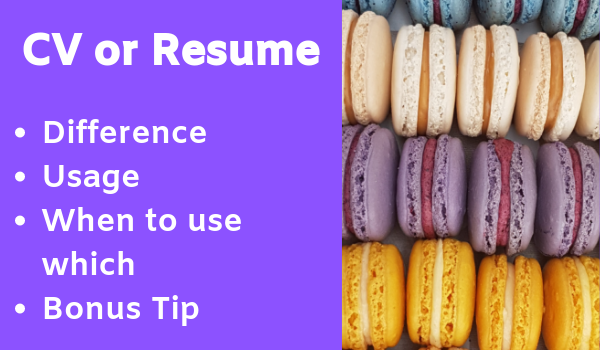- What is a resume?
- What is a CV?
- Differences between a CV and a resume
- The contents of a resume
- The contents of a CV
- Resume, CV and biodata – Usage around the world
- When should you use a CV, resume and biodata?
- Tips to keep in mind when writing a CV, Resume or Biodata
We often interchangeably use the terms ‘resume’ and ‘CV’, for they are assumed to be one and the same. But, contextually, a resume is very different from a CV or curriculum vitae. They both have different motives and are used by job seekers (mostly outside India) for their respective requirements in the job application process.
What is a resume?
A resume is typically a one-page document containing all your professional details and educational information in a summarised and easy-to-understand format.
Since we’re already discussing resumes, you may want to look at this too: Resume Objective Examples
What is a CV?
A curriculum vitae or CV is a deeper and more detailed version of the resume. Its length can vary from two to three pages or longer, depending on the job role and information. A CV gives the employer an exhaustive and clear insight into your professional roles and responsibilities.
Include these tips to enhance your CV: CV Do’s and Don’ts
Differences between a CV and a resume
The primary difference between a CV and a resume is in the information they carry. While both are used effectively in applying jobs, their respective differences make for different uses. Below is a point-by-point comparison of a CV and a resume:
|
CV |
Resume |
|
Can be three or more pages long. |
Is usually one to two pages long. |
|
Does not have a specific layout. |
Has customisable layout options. |
|
Used by applicants in academic roles. |
Used by applicants of any industry. |
|
Focuses on career progression in detail. |
Focuses on job skills. |
The contents of a resume
The primary contents of a resume include contact details, professional summary, work experience, skills and qualifications. The order and priority of these sections may change according to different resume formats. This is like a synopsis of your entire educational and professional details that the recruiter can peruse at a glance.
As a basic brief your working history and education over one to two pages, a resume consists of the following sections:
- Your full name
- Contact details – Mobile and email
- Professional summary
- Skills – Can be divided into technical skills and soft skills
- Work history – Only name of employer and duration of work is enough. You may highlight important duties performed in a bulleted list
- Education – Course names along with their respective universities and schools
Check out these useful verbs to boost your resume: Power your Resume with Action Verbs
The contents of a CV
A CV, on the other hand, is where you would go into the details of your various duties and responsibilities. Typically, a CV is created for jobs in academia and research fields, where you need to provide an extensive, comprehensive listing of everything from your education, degrees and certifications to your research experience, awards, publications, presentations, professional affiliations and memberships.
With a much more detailed set of information spread across more than two pages, a CV would typically have the following sections:
- Achievements
- Education
- Positions held
- Work experience
- Publications
- Awards
- Research
- Degrees
- Presentations
- Grants
- Honours
- Scholarly and professional affiliations
Is this your first time writing your CV? Read this: Writing your First Professional CV
Bonus tip: Resume, CV and biodata – Usages around the world
As we have learned so far, both ‘resume’ and ‘CV’ are different terms with different contexts, they can still be used for one another. India, Australia and South Africa use both ‘resume’ and ‘CV’ interchangeably in the job application process.
Resume: Offering a professional and educational summary of the applicant, it is the most common application document preferred by recruiters in the US and Canada.
CV: Displaying the applicant’s entire career progression in detail, it is more common in the UK, Ireland, New Zealand and Germany.
Biodata: A biodata is mostly used in India where the applicant’s personal details are added before the professional details. This includes information about the person’s date of birth, gender, religion, nationality, residence, marital status, and so on.
When should you use a CV, resume and biodata?
While the CV, resume, and biodata are all used for applying to jobs, you must know when to use which application. Here is your guide:
|
CV |
Resume |
Biodata |
|
When applying to roles in academia such as for PhD, doctorate, teaching or lectureship roles, clinical medical roles, etcetera. |
Can be used to apply for job roles in any industry, unless the recruiter has specifically asked for a CV or biodata. |
When applying to government jobs where your personal details are required in addition to your professional ones. |
Tips to keep in mind when writing a CV, Resume or Biodata
- Use keywords from the job description of the advertised role. The idea is to try and match your candidature to the job as much as possible.
- Follow a consistent style. Having consistency in your formatting adds a professional touch. It also helps you neatly lay out information.
- Make sure to proof-check everything. No matter how careful you are while writing, you may still find errors upon re-reading your CV, resume or biodata.
You may also like to read:




